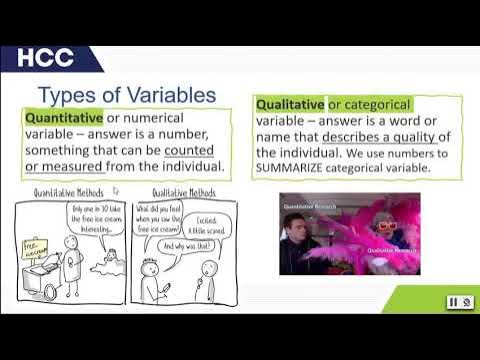Continuous vs Discrete Data
Summary
TLDRThis video explains the difference between continuous and discrete data. Continuous data can take any value within a given range, like temperature or speed, and can be measured with decimals. In contrast, discrete data involves countable, specific values, such as the number of cats or students. The video also provides examples to distinguish between these two types of data, including the distinction between rounded and exact ages. It concludes by showing how graphs represent each type of data, with continuous data depicted by smooth, connected lines and discrete data represented by separate points.
Takeaways
- 😀 Continuous data can take any value within an interval, including decimals and fractions.
- 😀 Discrete data only includes specific values, typically whole numbers.
- 😀 An example of continuous data is temperature, which can be measured with decimal precision.
- 😀 Discrete data can be counted, like the number of cats in a neighborhood or the number of doctors in a town.
- 😀 Continuous data can be measured, while discrete data is counted.
- 😀 The speed of a car is continuous data because it can be measured to any precision (e.g., 25.6 miles per hour).
- 😀 The number of cats in a neighborhood is discrete because it can only take on whole values (e.g., 5 or 12 cats).
- 😀 Body weight is continuous data, as it can be measured with decimals (e.g., 160.3 lbs).
- 😀 The number of students in a classroom is discrete data, as it involves counting distinct students.
- 😀 A graph with connected data points represents continuous data, while discrete data is represented by unconnected points.
Q & A
What is continuous data?
-Continuous data refers to data that can take any value within a given interval. It is typically measured, and can include decimal or fractional values. For example, the temperature can be 83.6°F or 99.46°F, showcasing the variability within an interval.
What is discrete data?
-Discrete data refers to data that can only take specific, distinct values. It is counted, not measured. Examples include the number of cats in a neighborhood or the number of doctors in a town, where you can only count whole numbers.
Can the speed of a car be considered continuous or discrete data?
-The speed of a car is continuous data because it can be measured and take on any value, such as 25.6 miles per hour, 30 miles per hour, or 42.86 miles per hour, with decimal values.
Is the number of cats in a neighborhood continuous or discrete data?
-The number of cats in a neighborhood is discrete data because it can only be counted in whole numbers, such as 5, 12, or 18. You cannot have fractional cats.
What makes the height of a student continuous data?
-The height of a student is considered continuous data because it can be measured and can take any value, including decimal values, like 5.84 feet or 6.3 feet.
Why is the number of books on a shelf considered discrete data?
-The number of books on a shelf is discrete data because it can be counted in whole numbers. You can count 3 books, 5 books, but not 4.5 books.
What does it mean when age is rounded to the nearest whole number, and how does it affect data classification?
-When age is rounded to the nearest whole number, it becomes discrete data because it can only take on whole number values like 16, 19, or 22, eliminating any fractional ages.
How does your exact age classify as continuous data?
-Your exact age is considered continuous data because it can be measured with precision, allowing for values like 16.2 years, 19.3 years, or 23.958 years, representing the exact measurement rather than rounding.
How can you distinguish continuous and discrete data on a graph?
-On a graph, continuous data is represented by a smooth, connected line, indicating that the data can take any value within the range. Discrete data is shown as distinct, unconnected points, representing countable values.
Why is rolling a six-sided die considered an example of discrete data?
-Rolling a six-sided die is discrete data because the outcomes are limited to specific whole numbers (1, 2, 3, 4, 5, or 6). You cannot roll a value like 2.37 or 4.6.
Outlines

This section is available to paid users only. Please upgrade to access this part.
Upgrade NowMindmap

This section is available to paid users only. Please upgrade to access this part.
Upgrade NowKeywords

This section is available to paid users only. Please upgrade to access this part.
Upgrade NowHighlights

This section is available to paid users only. Please upgrade to access this part.
Upgrade NowTranscripts

This section is available to paid users only. Please upgrade to access this part.
Upgrade NowBrowse More Related Video
5.0 / 5 (0 votes)





